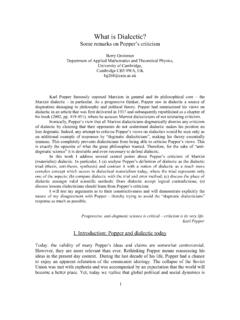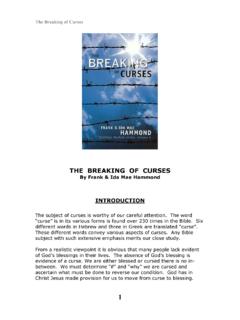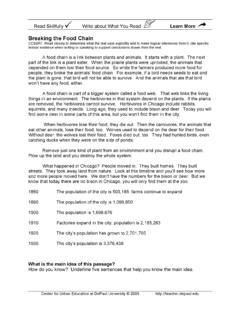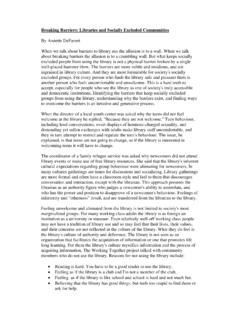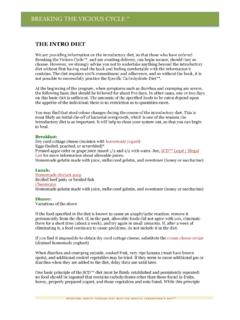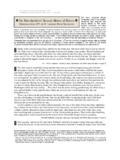Transcription of Spontaneous symmetry breaking in the Higgs mechanism
1 Spontaneous symmetry breaking in the Higgs mechanismAugust 2012 AbstractThe Higgs mechanism is very powerful: it furnishes a description of the elec-troweak theory in the Standard Model which has a convincing experimental ver-ification. But although the Higgs mechanism had been applied successfully, theconceptual background is not clear. The Higgs mechanism is often presented asspontaneous breaking of a local gauge symmetry . But a local gauge symmetry isrooted in redundancy of description: gauge transformations connect states thatcannot be physically distinguished. A gauge symmetry is therefore not a sym-metry of nature, but of our description of nature. The Spontaneous breaking ofsuch a symmetry cannot be expected to have physical e ects since asymmetriesare not reflected in the physics.
2 If Spontaneous gauge symmetry breaking cannothave physical e ects, this causes conceptual problems for the Higgs mechanism , iftaken to be described as Spontaneous gauge symmetry a gauge invariant theory, gauge fixing is necessary to retrieve the physicsfrom the theory. This means that also in a theory with Spontaneous gauge sym-metry breaking , a gauge should be fixed. But gauge fixing itself breaks the gaugesymmetry, and thereby obscures the Spontaneous breaking of the symmetry . Itsuggests that Spontaneous gauge symmetry breaking is not part of the physics,but an unphysical artifact of the redundancy in , the Higgs mechanism can be formulated in a gauge independent way,without Spontaneous symmetry breaking .
3 The same outcome as in the accountwith Spontaneous symmetry breaking is obtained. It is concluded that even thoughspontaneous gauge symmetry breaking cannot have physical consequences, theHiggs mechanism is not in conceptual danger. The mechanism relies on the non-zero ground state value of the Higgs field, rather than on Spontaneous Introduction32 Global, local and gauge symmetries53 Mass and renormalization114 Spontaneous breaking of global Spontaneous symmetry breaking in a ferromagnet .. Spontaneous breaking of global U(1) symmetry .. The Goldstone theorem ..195 The Higgs mechanism as Spontaneous gauge symmetry breaking The Higgs mechanism .. Breakdown of the Goldstone theorem.
4 256 The Higgs mechanism without Spontaneous symmetry breaking 267 Conclusions2921 IntroductionThe Higgs mechanism is an important part of the Standard Model of particlephysics. It provides the theory with mass for the gauge bosons of the weak inter-action and for the fermions. The electroweak theory in which it plays a prominentrole had a convincing experimental verification. The Higgs mechanism is gener-ally described as a case of Spontaneous symmetry breaking , such as in Peskin andSchroeder [36, Section ] and Weinberg [54, chapter 21].The notion of Spontaneous symmetry breaking (SSB) will be at the basis ofthis essay. To place the abstract ideas of SSB that will be discussed in a concretecontext, a very simple example of SSB will be described here, that can also befound in Ryder [38, pp.]
5 282, 283]. The example emphasizes that spontaneoussymmetry breaking is not the same as explicit breaking of a symmetry breaking is caused by an external force that actively breaks thesymmetry. It appears as a symmetry breaking term in the Lagrangian or in an-other formalism from which the equations of motion can be derived. Spontaneoussymmetry breaking however does not require such an external force; this is wherethe term Spontaneous comes from. The equations of motion and the Lagrangianthen still obey the spontaneously broken symmetry . The symmetry considered inthis example is the rotational symmetry of a rod around its axis as in figure 1(a).The symmetry can be broken by applying an external force to one end of the rod:the rod will bend and lose its rotational symmetry as in figure 1(b).
6 This is explicitsymmetry breaking : it is caused by an external force that enters the equations ofmotion. The case of Spontaneous symmetry breaking is encountered if a force isapplied in the longitudinal direction of the rod will now also bend andis no longer rotationally invariant (figure 1(c)). It is worth noting two propertiesof this spontaneously broken state. The first is that the direction in which therod bends is arbitrary - there are several ground states that could all equallywell be occupied: the ground states are degenerate. The second thing to noticeis that the di erent directions of bending (the di erent ground states) are relatedby the original rotational symmetry .
7 The symmetry has thus not disappeared butis hidden in the relation between the ground states. This reflects the fact thatthe equations of motion still obey the symmetry , although the ground states donot. For this reason Spontaneous symmetry breaking is sometimes called a hiddensymmetry .The usual account of the Higgs mechanism describes it as a case of spontaneoussymmetry breaking . The spontaneously broken symmetry is however not a phys-ical symmetry as in the example above. The rotational symmetry in the examplerelates observably di erent states: the ground states of the rod are physically dif-ferent. In the Higgs mechanism the symmetry that is spontaneously broken is nota physical symmetry , but a gauge symmetry .
8 A gauge symmetry relates statesthat are physically the same, but di er in their mathematical description. It isnot a symmetry of the physical states; it is a symmetry of the description of aphysical state. A more comprehensive study of the nature of gauge symmetries ispresented in section gauge transformations relate di erent descriptions of the same state, Spontaneous gauge symmetry breaking is di erent from the Spontaneous symme-try breaking of the physical symmetry above. The degenerate ground states ofthe system are not physically di erent in the case of gauge symmetry an external force is also applied here, this case can be justified as being spontaneoussymmetry breaking by considering that the applied force works perpendicular to the bending directionof the (a) Unbroken symmetry : therod in its original state is rota-tionally invariant(b) Explicitly broken symme-try: the rod bends due to an ex-ternal force and loses rotationalinvariance(c) Spontaneously brokensymmetry: the rod bendsin an arbitrary directionand loses rotational invari-anceFigure 1.
9 Spontaneous symmetry breaking as seen in the bending of a rodIt therefore does not matter which ground state the system picks : all states de-scribe the same physics. The asymmetry of the ground states has no physicalresults. Since a gauge symmetry is not a physical symmetry , Spontaneous break-ing of this symmetry cannot be expected to have physical consequences. But theHiggs mechanism does have physical consequences: it gives mass to the particlesin the standard model. This causes a conceptual problem about the Higgs mech-anism: if gauge symmetry breaking cannot have physical consequences, how canthe Higgs mechanism which is a case of gauge symmetry breaking , have any?This conceptual problem has concerned philosophers of physics since Earman[9] in 2002 called for the investigation of this subject.
10 In Brading and Castellani [6,part III] (2003) many aspects of symmetry breaking are addressed. Smeenk [43]gives a good overview of the role of gauge symmetry breaking in the Higgs mecha-nism. A debate on the ontology and explanatory power of the Higgs mechanism isfound in three subsequent papers by Lyre [31], W uthrich [56] and again Lyre [32].Kosso [29] investigates the epistemology of broken symmetries and questions theanalogy between electromagnetism and the weak theory as regards their basis ingauge symmetry . Indeed, the conceptual discussion about the Higgs mechanismis not only due to philosophers of physics. Articles by Witten [55] and t Hooft[47, pp. 65 - 95] also contribute to the erent approaches to Spontaneous symmetry breaking are followed in theliterature.

